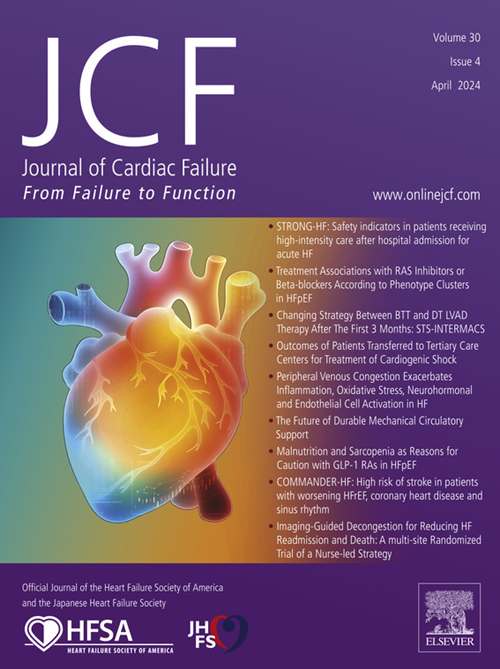Underpinnings of Heart Failure With Preserved Ejection Fraction in Women - From Prevention to Improving Function. A Co-publication With the American Journal of Preventive Cardiology and the Journal of Cardiac Failure
IF 8.2
2区 医学
Q1 CARDIAC & CARDIOVASCULAR SYSTEMS
引用次数: 0
Abstract
Heart failure with preserved ejection fraction (HFpEF) represents a major clinical challenge with rising global prevalence. Women have a nearly double lifetime risk of developing HFpEF compared to heart failure with reduced ejection fraction (HFrEF). In HFpEF, sex differences emerge both in how traditional cardiovascular risk factors (such as hypertension, obesity, and diabetes) affect cardiac function and through distinct pathophysiological mechanisms triggered by sex-specific events like menopause and adverse pregnancy outcomes. These patterns influence not only disease development, but also therapeutic responses, necessitating sex-specific approaches to treatment. This review aims to synthesize existing knowledge regarding HFpEF in women including traditional and sex-specific risk factors, pathophysiology, presentation, and therapies, while outlining important knowledge gaps that warrant further investigation. The impact of HFpEF spans a woman's entire lifespan, requiring prevention and management strategies tailored to different life stages. While understanding of sex-based differences in HFpEF has improved, significant knowledge gaps persist. Through examination of current evidence and challenges, this review highlights promising opportunities for innovative research, therapeutic development, and clinical care approaches that could transform the management of HFpEF in women.
保留射血分数的女性心力衰竭的基础——从预防到改善功能。与美国预防心脏病学杂志和心力衰竭杂志共同发表。
保留射血分数的心力衰竭(HFpEF)是全球患病率上升的主要临床挑战。与射血分数降低(HFrEF)的心力衰竭相比,女性发生HFpEF的风险几乎是其终生风险的两倍。在HFpEF中,性别差异体现在传统心血管危险因素(如高血压、肥胖和糖尿病)如何影响心功能,以及由性别特异性事件(如更年期和不良妊娠结局)触发的不同病理生理机制。这些模式不仅影响疾病的发展,而且影响治疗反应,因此需要采取针对性别的治疗方法。本综述旨在综合现有关于女性HFpEF的知识,包括传统和性别特异性风险因素、病理生理学、表现和治疗,同时概述了值得进一步研究的重要知识空白。HFpEF的影响贯穿女性的整个生命周期,需要针对不同生命阶段量身定制预防和管理策略。虽然对HFpEF的性别差异的了解有所改善,但仍然存在重大的知识差距。通过对现有证据和挑战的审查,本综述强调了创新研究、治疗开发和临床护理方法的有希望的机会,这些机会可以改变妇女HFpEF的管理。
本文章由计算机程序翻译,如有差异,请以英文原文为准。
求助全文
约1分钟内获得全文
求助全文
来源期刊

Journal of Cardiac Failure
医学-心血管系统
CiteScore
7.80
自引率
8.30%
发文量
653
审稿时长
21 days
期刊介绍:
Journal of Cardiac Failure publishes original, peer-reviewed communications of scientific excellence and review articles on clinical research, basic human studies, animal studies, and bench research with potential clinical applications to heart failure - pathogenesis, etiology, epidemiology, pathophysiological mechanisms, assessment, prevention, and treatment.
 求助内容:
求助内容: 应助结果提醒方式:
应助结果提醒方式:


